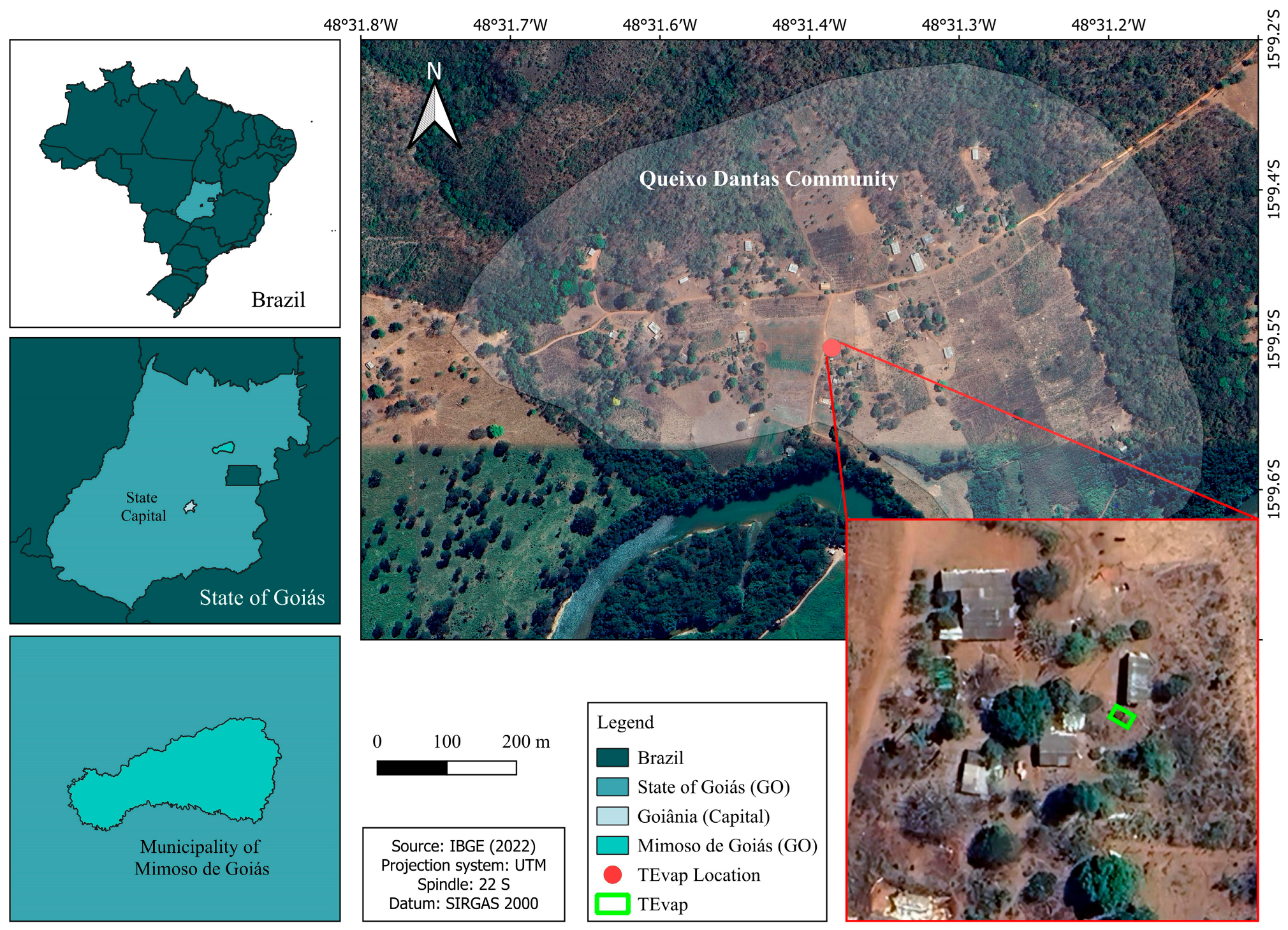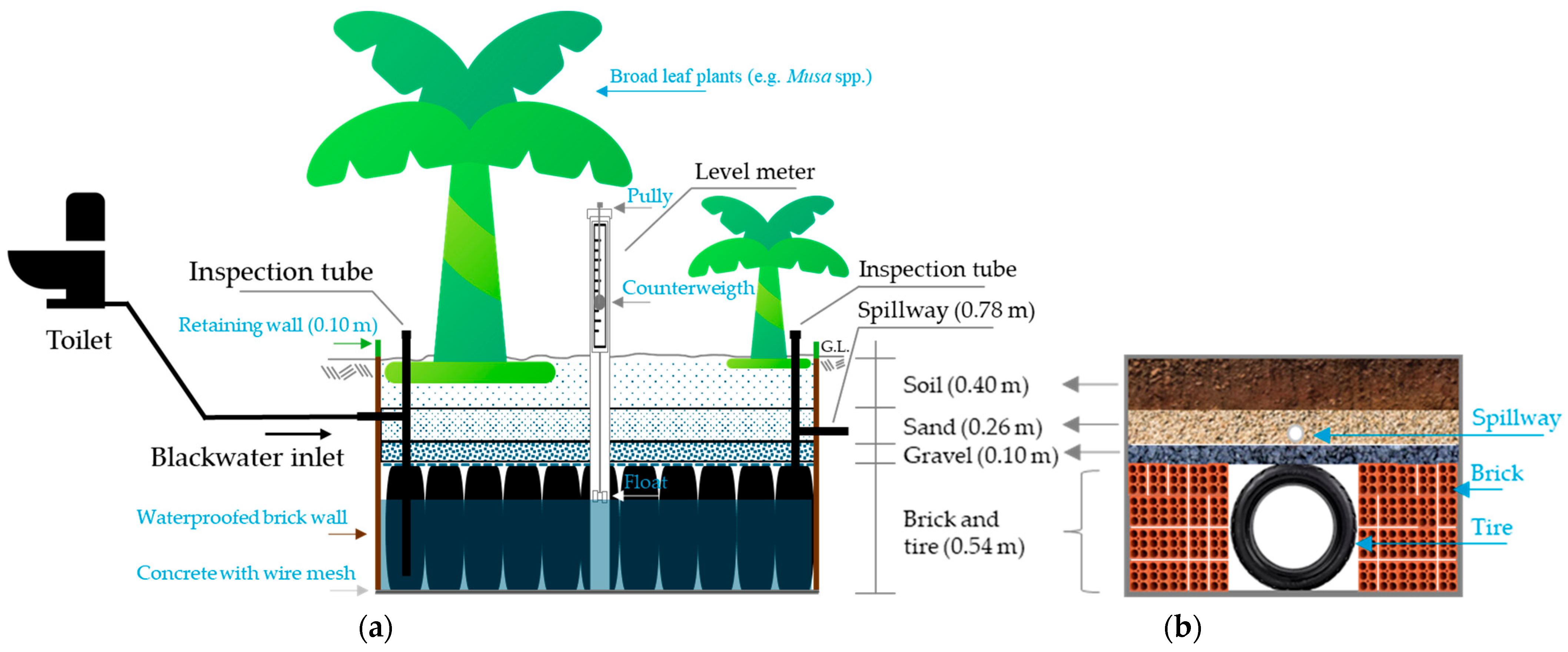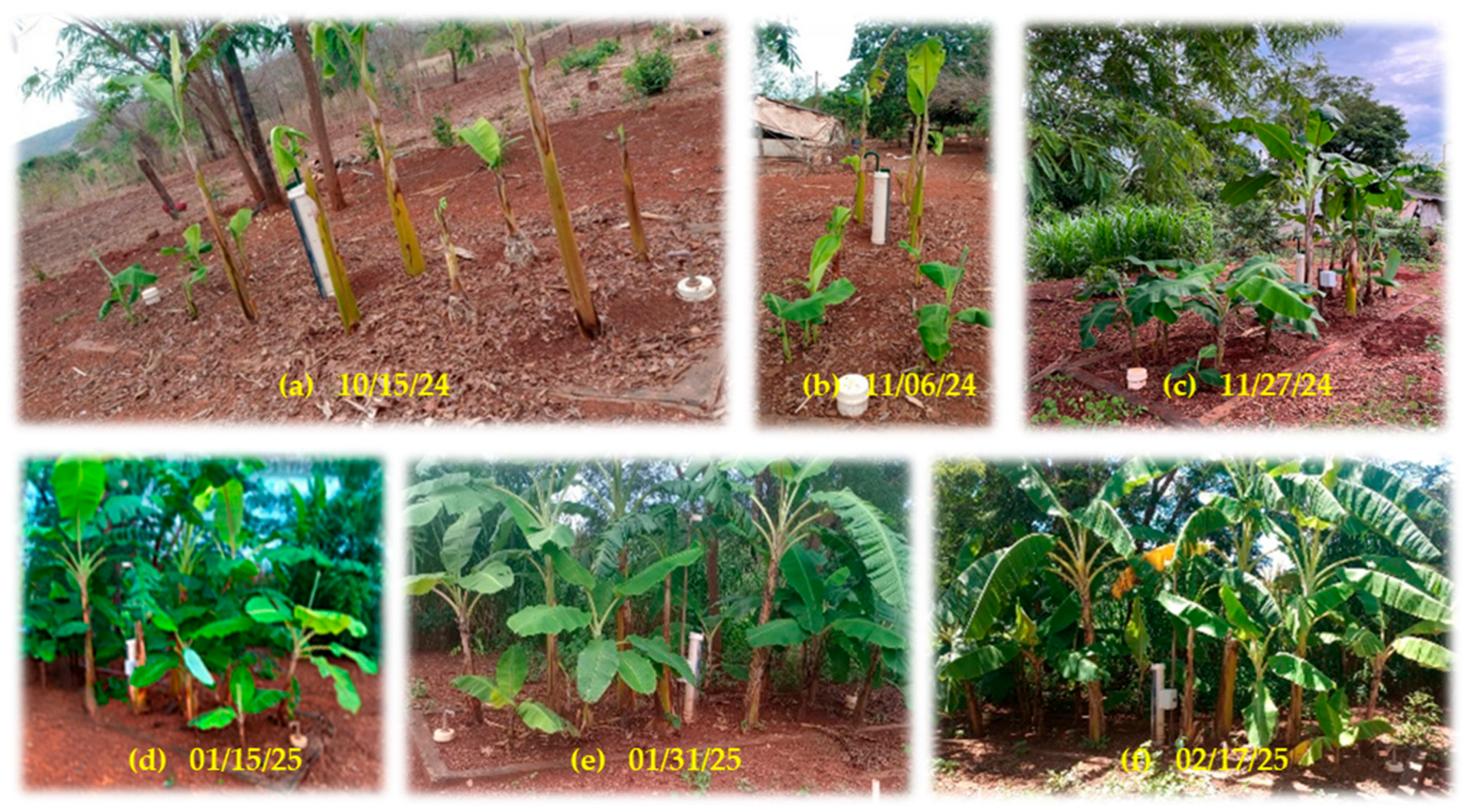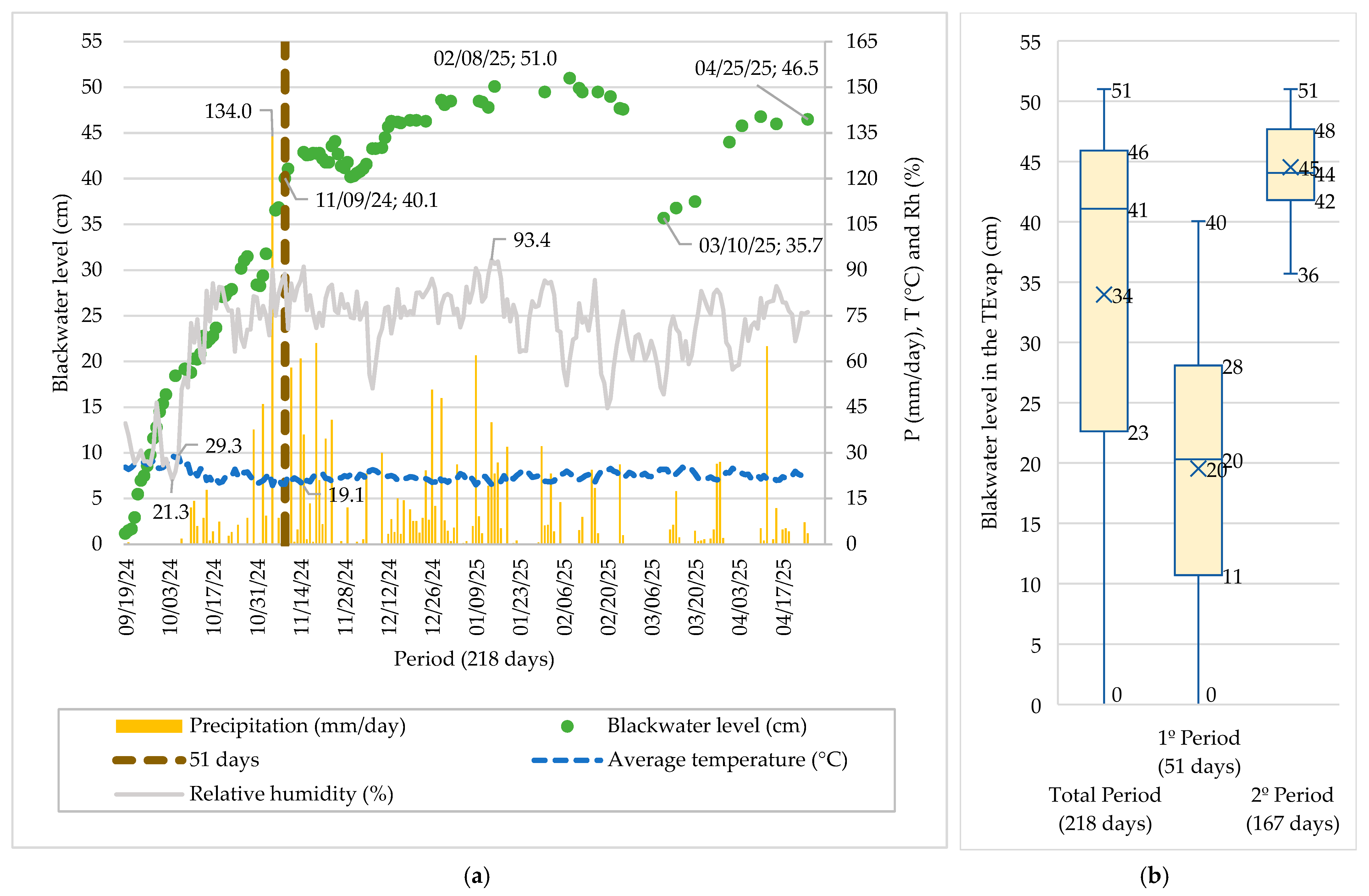Operation of a Zero-Discharge Evapotranspiration Tank for Blackwater Disposal in a Rural Quilombola Household, Brazil
Abstract
1. Introduction
2. Materials and Methods
2.1. Study Area
2.2. TEvap Characteristics
2.3. Community Construction of the TEvap
2.4. TEvap Monitoring
2.5. Blackwater Sampling
2.6. Water Balance in TEvap
3. Results
3.1. Community Involvement in the Construction of the Tevap
3.2. TEvap Monitoring
3.2.1. Assessment of the Blackwater Inside the TEvap
3.2.2. Blackwater Levels Inside the TEvap and Water Balance
4. Discussion
“I am very happy to receive the TEvap. Now I know that banana plants help to treat the sewage that we generate every day. Thank you!”
“Wow, now the yard is so much better without the stench of sewage around the house.”
5. Recommendation
6. Conclusions
Supplementary Materials
Author Contributions
Funding
Data Availability Statement
Acknowledgments
Conflicts of Interest
References
- López-Vinent, N.; Santacruz, A.P.; Sales-Alba, A.; Cruz-Alcalde, A.; Redondo, I.D.; Pérez, S.; Sans, C. Nature-Based Solution as an Efficient Wastewater Pretreatment to Enhance Micropollutants Abatement by Solar Photo-Fenton at Natural pH. J. Environ. Chem. Eng. 2023, 11, 110834. [Google Scholar] [CrossRef]
- Tian, A.; Chang, Y.; Yao, D.; Zhou, Y.; Xu, Q.; Tang, Q. A Modular Coupling System for EfficientTreatment of Rural Domestic Wastewater. Pol. J. Environ. Stud. 2023, 32, 1371–1381. [Google Scholar] [CrossRef] [PubMed]
- Ma, L.; Li, Z.; Liu, G.; Liu, W. Low-Level Cadmium Alleviates the Disturbance of Doxycycline on Nitrogen Removal and N2O Emissions in Ditch Wetlands by Altering Microbial Community and Enzymatic Activity. J. Clean. Prod. 2023, 387, 135807. [Google Scholar] [CrossRef]
- Gomes, É.O.; Bomfim, T.O.D.; Santos, R.L.; Cohim, E.H.B.; Melo, S.L.D.; Machado, A.R.; Carvalho, D.E.B.D.; Silva, P.V.S.R. Avaliação do impacto ambiental de dois sistemas de tratamento de esgoto, reator uasb e lagoa anaeróbia: Uma análise no ciclo de vida (ACV). Rev. Contemp. 2024, 4, e3981. [Google Scholar] [CrossRef]
- World Health Organization. Guidelines on Sanitation and Health; World Health Organization: Geneva, Switzerland, 2018. [Google Scholar]
- Cruz, N.; Mierzwa, J.C. Saúde Pública e Inovações Tecnológicas Para Abastecimento Público. Saude Soc. 2020, 29, e180824. [Google Scholar] [CrossRef]
- United Nations. Transforming Our World: The 2030 Agenda for Sustainable Development, 2015. Available online: https://sustainabledevelopment.un.org/post2015/transformingourworld (accessed on 5 March 2025).
- United Nations. ODS 6, 2020. Available online: https://unstats.un.org/sdgs/report/2020/goal-06/ (accessed on 16 March 2025).
- Pinilla-Rodríguez, D.E.; Torres-Sánchez, Y.A. Gasto Público Social, El Acceso al Agua Potable y El Saneamiento de Las Poblaciones Rurales En América Latina. RPD 2019, 50, 196. [Google Scholar] [CrossRef]
- Queiroz, V.C.; Carvalho, R.C.D.; Heller, L. New Approaches to Monitor Inequalities in Access to Water and Sanitation: The SDGs in Latin America and the Caribbean. Water 2020, 12, 931. [Google Scholar] [CrossRef]
- SNIS. Panorama do Saneamento Básico no Brasil 2021, 2021. Available online: https://www.gov.br/cidades/pt-br/acesso-a-informacao/acoes-e-programas/saneamento/snis/produtos-do-snis/PANORAMA_DO_SANEAMENTO_BASICO_NO_BRASIL_SNIS_2021compactado.pdf (accessed on 16 June 2025).
- Mejía, A.; Castillo, O.; Vera, R. Agua Potable y Saneamiento en la Nueva Ruralidad de América Latina; Banco de Desarrollo de Americo Latina-CAF: Bogotá, Colombia, 2016. [Google Scholar]
- Maciel, J.K.V.S.; Feitosa, P.H.C.; De Araújo, M.M.C.; Rocha, E.G.; Batista, G.D.S.; Fonseca, R.F.D.N.; Feitosa, F.C.; Leite, L.L. Avaliação dos Sistemas de Tratamento de Esgoto em Municípios de Pequeno Porte na Paraíba. OLEL 2023, 21, 17344–17362. [Google Scholar] [CrossRef]
- Brasil. Decreto N° 8.750, 2016. Available online: https://www.planalto.gov.br/ccivil_03/_ato2015-2018/2016/decreto/d8750.htm (accessed on 10 March 2025).
- Brasil. Decreto No 4.887, 2003. Available online: https://www.planalto.gov.br/ccivil_03/decreto/2003/d4887.htm (accessed on 5 March 2025).
- IBGE. Censo Demográfico, 2022. Available online: https://cidades.ibge.gov.br/brasil/panorama (accessed on 11 June 2025).
- Vale, G.B.D.; Ruggeri Junior, H.C.; Scalize, P.S. Service and Precariousness of Sanitary Sewage in Rural Communities in the State of Goiás, Brazil. Eng. Sanit. Ambient. 2022, 27, 1067–1075. [Google Scholar] [CrossRef]
- Marcon, A.M.; Wesz Junior, V.J. The “New” Legal Framework and the Universalization of Basic Sanitation in Rural Areas. Rev. Bras. Estud. Urbanos Reg. 2024, 26, e202441pt. [Google Scholar] [CrossRef]
- Jegatheesan, V.; Pachova, N.; Velasco, P.; Mowjood, M.I.M.; Weragoda, S.K.; Makehelwala, M.; Trang, N.T.D.; Dang, B.; Tran, C.; Vo, T.; et al. Co-development of an Integrated Assessment Framework to Evaluate the Effectiveness and Impact of Selected Nature-based Water Treatment Technologies in Sri Lanka, The Philippines, and Vietnam. Environ. Qual. Mgmt 2023, 32, 335–365. [Google Scholar] [CrossRef]
- Galbiati, A.F. Tratamento Domiciliar de Águas Negras Através de Tanque de Evapotranspiração, 2009. Available online: https://repositorio.ufms.br/bitstream/123456789/1163/1/Adriana%20Farina%20Galbiati.pdf (accessed on 10 March 2025).
- Figueiredo, I.C.S.; Barbosa, A.C.; Miyazaki, C.K.; Schneider, J.; Coasaca, R.L.; Magalhães, T.M.; Tonetti, A.L. Bacia de Evapotranspiração (BET): Uma Forma Segura e Ecológica de Tratar o Esgoto de Vaso Sanitário. R. DAE 2019, 67, 115–127. [Google Scholar] [CrossRef]
- Ferreira, M.M.; Fiore, F.A.; Saron, A.; Da Silva, G.H.R. Systematic Review of the Last 20 Years of Research on Decentralized Domestic Wastewater Treatment in Brazil: State of the Art and Potentials. Water Sci. Technol. 2021, 84, 3469–3488. [Google Scholar] [CrossRef] [PubMed]
- Pamplona, S.; Venturi, M. Esgoto à flor da terra. In Esgoto à Flor da Terra—Sistema de Evapotranspiração é Solução Simples, Acessível e Sustentável; Fazenda Experimental da Ressacada: Florianópolis, Brazil, 2004; pp. 18–19. [Google Scholar]
- Paulo, P.L.; Galbiati, A.F.; Magalhães Filho, F.J.C. CataloSan: Catálogo de Soluções Sustentáveis de Saneamento: Gestão de Efluentes Domésticos, 1st ed.; Fundação Nacional de Saúde: Brasília, Brazil, 2018.
- Coelho, C.F.; Reinhardt, H.; Araújo, J.C.D. Fossa Verde Como Componente de Saneamento Rural Para a Região Semiárida do Brasil. Eng. Sanit. Ambient. 2018, 23, 801–810. [Google Scholar] [CrossRef]
- Figueiredo, I.C.S.; Dos Santos, B.S.C.; Tonetti, A.L. Tratamento de Esgoto Na Zona Rural: Fossa Verde e Círculo de Bananeiras, 1st ed.; FECFAU: Campinas, Brazil, 2018. [Google Scholar]
- Reis, M.C.G.; Borges, A.C.; Ferreira, F.S.; Cunha, F.F.D.; Da Silva, R.R. A Preliminary Experimental Study Simulating Evapotranspiration Process in TEvap Tanks Cultivated with Different Forages. Environ. Technol. 2024, 45, 3129–3140. [Google Scholar] [CrossRef] [PubMed]
- Paulo, P.L.; Galbiati, A.F.; Magalhães Filho, F.J.C.; Bernardes, F.S.; Carvalho, G.A.; Boncz, M.Á. Evapotranspiration Tank for the Treatment, Disposal and Resource Recovery of Blackwater. Resour. Conserv. Recycl. 2019, 147, 61–66. [Google Scholar] [CrossRef]
- Paulo, P.L.; Azevedo, C.; Begosso, L.; Galbiati, A.F.; Boncz, M.A. Natural Systems Treating Greywater and Blackwater On-Site: Integrating Treatment, Reuse and Landscaping. Ecol. Eng. 2013, 50, 95–100. [Google Scholar] [CrossRef]
- Magalhães Filho, F.J.C.; De Queiroz, A.A.F.S.L.; Machado, B.S.; Paulo, P.L. Sustainable Sanitation Management Tool for Decision Making in Isolated Areas in Brazil. IJERPH 2019, 16, 1118. [Google Scholar] [CrossRef] [PubMed]
- Machado, G.C.X.M.P.; Roale, C.; Sobrinho, F.X.; Ruprecht, T.; Oliveira, F.J.d.R. Caminhos e Cuidados Com as Águas: Faça Você Mesmo seu Sistema de Saneamento Ecológico, 23rd ed.; Fundação Oswaldo Cruz: Rio de Janeiro, Brazil, 2019.
- Reis, M.C.G.; Borges, A.C.; Cunha, F.F.D.; Silva, R.R.D. Evapotranspiration Beds as a Zero-Discharge Nature-Based Solution for Wastewater Disposal: A Review. Ecol. Eng. 2023, 189, 106896. [Google Scholar] [CrossRef]
- Alvares, C.A.; Stape, J.L.; Sentelhas, P.C.; De Moraes Gonçalves, J.L.; Sparovek, G. Köppen’s Climate Classification Map for Brazil. Metz 2013, 22, 711–728. [Google Scholar] [CrossRef] [PubMed]
- Costa, H.C.; Marcuzzo, F.; Ferreira, O.M.; Andrade, L.R. Espacialização e Sazonalidade Da Precipitação Pluviométrica Do Estado de Goiás e Distrito Federal (Seasonality and Spatial Distribution of Rainfall in the State of Goiás and Federal District). Rev. Bras. Geog. Fis. 2012, 5, 87–100. [Google Scholar] [CrossRef]
- Scalize, P.S.; Rocha, B.S.; Lopes, D.P.; Lopes, H.T.L.; Ruggeri Junior, H.C.; Roque e Lima, J.d.O.; Mendonça, J.S.A.; Hora, E.R.; Santo Filho, K.d.E.; Moreira, L.P.; et al. Diagnóstico Técnico Participativo da Comunidade de Mimoso (Queixo Dantas), Mimoso de Goiás, Goiás, 2019, 1st ed.; Cegraf UFG: Goiânia, Brazil, 2021. [Google Scholar]
- Pires, F.J. Construção Participativa de Sistemas de Tratamento de Esgoto Doméstico no Assentamento Rural Olga Benário—MG, 2012. Available online: https://locus.ufv.br/items/eeba88f8-5c90-4fd1-98c6-47a0ae20f085 (accessed on 14 January 2025).
- Embrapa. A Cultura da Banana, 3rd ed.; Embrapa: Brasília, Brazil, 2006.
- BCB. Cotações, 2025. Available online: https://www.bcb.gov.br/ (accessed on 12 June 2025).
- Arias, F. El Proyecto de Investigación. Introducción a la Metodología Científica, 6th ed.; Central University of Venezuela: Caracas, Venezuela, 2012. [Google Scholar]
- Balestrini, M.A. Como se Elabora el Proyecto de Investigación, 7th ed.; Consultores Asociados: Caracas, Venezuela, 2005. [Google Scholar]
- Sillva, A.C.; Carrillo, A.D.D.; Scalize, V.B.; Lamarre, K.; Ruggeri Junior, H.C.; Albuquerque, A.; Scalize, P.S. Variação Do Volume Útil Em Bacia de Evapotranspiração Para Tratamento de Esgoto Faecal, 2024. Available online: https://iceubi2024.pt/wp-content/uploads/2025/01/LIVRO-DE-ATAS_FINAL-07_01_2025-1.pdf (accessed on 12 June 2025).
- Rose, C.; Parker, A.; Jefferson, B.; Cartmell, E. The Characterization of Feces and Urine: A Review of the Literature to Inform Advanced Treatment Technology. Crit. Rev. Environ. Sci. Technol. 2015, 45, 1827–1879. [Google Scholar] [CrossRef] [PubMed]
- APHA. Standard Methods for the Examination of Water and Wastewater; APHA: Washington, DC, USA, 2023.
- Embrapa. O Cultivo da Bananeira, 1st ed.; Embrapa: Brasília, Brazil, 2004.
- Costa, S.C.; Soares, A.A.; Sediyama, G.C.; Viana, T.V.D.A.; Moreira, F.V.D.O. Variação de parâmetros físicos e químicos de frutos em bananeira ‘pacovan’ submetida a diferentes lâminas de irrigação e doses de potássio na Chapada do Apodi—Limoeiro do Norte-CE. IRRIGA 2011, 16, 82. [Google Scholar] [CrossRef]
- INMET. Mapa Interativo de Monitoramento Meteorológico. Available online: https://mapas.inmet.gov.br/ (accessed on 18 March 2025).
- Callegari-Jacques, S.M. Bioestatística: Princípios e Aplicações; Amazon Technologies, Inc.: Seattle, WA, USA, 2008. [Google Scholar]
- Oliveira, C.G.D.; Chaves, S.R.M.; Carvalho, L.R.D.; Morais, T.D.F.; Lourenço, A.M.G. Disseminação de Tecnologias Sociais Para Tratamento de Esgoto Doméstico Na Zona Rural de Princesa Isabel—PB e Região. RPSE 2020, 8, 99. [Google Scholar] [CrossRef]
- Dos Santos, J.L.; Dos Santos, C.A.P. Educação ambiental como instrumento do saneamento em comunidade quilombola, Entre Rios—BA. Rev. Geogr. Acad. 2022, 15, 121–134. [Google Scholar]
- Machado, G.C.X.M.P.; Haguenauer, C.J.; Ruprecht, T.; Sobrinho, F.X.; Gallo, E. Ecological Sanitation: A Territorialized Agenda for Strengthening Traditional Communities Facing Climate Change. In Climate Change Adaptation in Latin America; Leal Filho, W., Esteves De Freitas, L., Eds.; Climate Change Management; Springer International Publishing: Cham, Switzerland, 2018; pp. 103–129. [Google Scholar] [CrossRef]
- Allen, R.G.; Pereira, L.S.; Raes, D.; Smith, M. Crop Evapotranspiration Guidelines for Computing Crop Water Requirements; FAO: Rome, Italy, 1998. [Google Scholar]
- Embrapa. Sistema de Produção da Bananeira Irrigada; Embrapa: Brasília, Brazil, 2009.
- Curneen, S.; Gill, L. Upflow Evapotranspiration System for the Treatment of On-Site Wastewater Effluent. Water 2015, 7, 2037–2059. [Google Scholar] [CrossRef]
- Frank, P.E.W.L. Engineering Parameters in the Design of Evapotranspiration Beds, 2000. Available online: https://www.wwdmag.com/wastewater-treatment/article/10917092/engineering-parameters-in-the-design-of-evapotranspiration-beds (accessed on 14 April 2025).
- Da Silva, A.C.; Scalize, P.S.; Albuquerque, A. Assessment of per Capita Contribution to Fecal Sewage in Rural Residences of Quilombola Communities. Water 2025, 17, 1350. [Google Scholar] [CrossRef]
- Metcalf&Eddy. Wastewater Engineering: Treatment and Resource Recovery, 5th ed.; Amazon Technologies, Inc.: Seattle, WA, USA, 2014. [Google Scholar]
- Balley, P.; Dakers, A.J. Non-Discharging Evapotranspiration Bed System for Wastewater Disposal at Lincoln. Environ. Monit. Assess. 1996, 43, 65–72. [Google Scholar] [CrossRef] [PubMed]
- Beebe, D.A.; Castle, J.W.; Molz, F.J.; Rodgers, J.H. Effects of Evapotranspiration on Treatment Performance in Constructed Wetlands: Experimental Studies and Modeling. Ecol. Eng. 2014, 71, 394–400. [Google Scholar] [CrossRef]
- Embrapa. Irrigação da Bananeira; Embrapa: Brasília, Brazil, 2012.
- Santos Junior, E.L.d. Tecnologia Alternativa para Tratamento Seletivo dos Resíduos Provenientes da Bacia Sanitária em Comunidades Rurais, 2019. Available online: https://tede.unioeste.br/handle/tede/4203 (accessed on 15 April 2025).
- ANA. Conjetura de Recursos Hídricos no Brasil, 2017. Available online: https://www.snirh.gov.br/portal/snirh/centrais-de-conteudos/conjuntura-dos-recursos-hidricos/conj2017_rel-1.pdf (accessed on 12 June 2025).
- Kujawa-Roeleveld, K.; Zeeman, G. Anaerobic Treatment in Decentralised and Source-Separation-Based Sanitation Concepts. Rev. Environ. Sci. Biotechnol. 2006, 5, 115–139. [Google Scholar] [CrossRef]
- Costa, T.H.S.; Mota, F.S.B. Análise Quantitativa de Águas Cinza Em Um Condomínio Residencial. Eng. Sanit. Ambient. 2022, 27, 413–421. [Google Scholar] [CrossRef]







| Sample | pH | EC (mS/m) | Color (Uc) | Tur. (NTU) | COD (mg.L−1) | BOD5 (mg.L−1) |
|---|---|---|---|---|---|---|
| QD1 | 7.7 | 2.8 | 312.0 | 529.0 | 1755.0 | 451.0 |
| QD2 | 7.5 | 2.9 | 256.0 | 54.2 | 446.5 | 84.0 |
| Efficiency (%) | 17.9 | 89.8 | 74.6 | 81.4 | ||
| Period | Total Days | Blackwater Level at TEvap (cm) | Blackwater Volume in TEvap (m3) | VBW (m3) | VFU (m3) (0.09 × VBW) | VI (m3) | VP (m3) | VEvap (m3) | VEvap (%) | ||
|---|---|---|---|---|---|---|---|---|---|---|---|
| Initial | Final | VBWi | VBWf | ||||||||
| P1 | 51 | 0.0 | 40.1 | 0.00 | 2.68 | 4.93 | 0.44 | 0.96 | 2.78 | 6.43 | 70.6 |
| P2 | 167 | 40.1 | 46.5 | 2.68 | 3.11 | 19.14 | 1.72 | 0.00 | 10.60 | 31.04 | 98.6 |
| TP | 218 | 0.0 | 46.5 | 0.00 | 3.11 | 24.07 | 2.16 | 0.96 | 13.39 | 37.47 | 92.3 |
Disclaimer/Publisher’s Note: The statements, opinions and data contained in all publications are solely those of the individual author(s) and contributor(s) and not of MDPI and/or the editor(s). MDPI and/or the editor(s) disclaim responsibility for any injury to people or property resulting from any ideas, methods, instructions or products referred to in the content. |
© 2025 by the authors. Licensee MDPI, Basel, Switzerland. This article is an open access article distributed under the terms and conditions of the Creative Commons Attribution (CC BY) license (https://creativecommons.org/licenses/by/4.0/).
Share and Cite
da Silva, A.C.; Carrillo, A.D.D.; Scalize, P.S. Operation of a Zero-Discharge Evapotranspiration Tank for Blackwater Disposal in a Rural Quilombola Household, Brazil. Water 2025, 17, 2098. https://doi.org/10.3390/w17142098
da Silva AC, Carrillo ADD, Scalize PS. Operation of a Zero-Discharge Evapotranspiration Tank for Blackwater Disposal in a Rural Quilombola Household, Brazil. Water. 2025; 17(14):2098. https://doi.org/10.3390/w17142098
Chicago/Turabian Styleda Silva, Adivânia Cardoso, Adriana Duneya Diaz Carrillo, and Paulo Sérgio Scalize. 2025. "Operation of a Zero-Discharge Evapotranspiration Tank for Blackwater Disposal in a Rural Quilombola Household, Brazil" Water 17, no. 14: 2098. https://doi.org/10.3390/w17142098
APA Styleda Silva, A. C., Carrillo, A. D. D., & Scalize, P. S. (2025). Operation of a Zero-Discharge Evapotranspiration Tank for Blackwater Disposal in a Rural Quilombola Household, Brazil. Water, 17(14), 2098. https://doi.org/10.3390/w17142098










